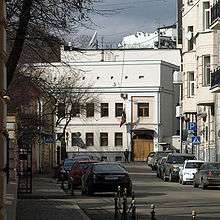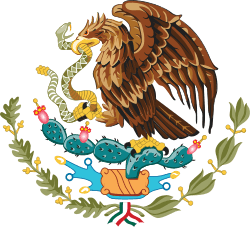Mexico–Russia relations
Mexico–Russia relations refers to the diplomatic relations between the United Mexican States and the Russian Federation. Both nations are members of the Asia-Pacific Economic Cooperation, G-20 major economies and the United Nations.
 | |
Mexico |
Russia |
|---|---|
History

In 1806 the Russian Empire under Emperor Alexander I, began an ambitious plan to expand its activities in Alaska (settled from the 1780s) and in California (then under control of the Spanish Empire). In 1806 the Russian diplomat and explorer Nikolai Rezanov arrived in California in order to secure food production for Russian fur-trade colonies. In 1812 the Russian-American Company established Fort Ross in present-day northern California.[1]
Mexico and Russia formally established diplomatic relations on 1 December 1890 in Mexico City, with Baron Roman Rosen representing Emperor Alexander III of Russia. In 1891 the first Russian legation opened in the Mexican capital.[1] During respective revolutions; 1910-1920 in Mexico and 1917 in Russia; diplomatic relations between the two countries were practically non-existent.
Soviet era
In 1922 Russia became known as the Union of Soviet Socialist Republics (USSR), In August 1924 Mexico became the first country in the American continent to establish relations with the USSR.[2] In 1926 the USSR appointed Alexandra Kollontai (the first female ambassador in the world) as ambassador to Mexico.[2]
On 26 January 1930 the two nations severed diplomatic relations due to "ideological differences". In 1936 the former Soviet politician Leon Trotsky and his wife Natalia Sedova, moved to Mexico from Norway during their exile. Mexican President Lázaro Cárdenas welcomed Trotsky warmly, even arranging for a special train to bring him to Mexico City from the port of Tampico. In Mexico, Trotsky at one point lived at the home of painters Diego Rivera and Frida Kahlo. In August 1940 an NKVD agent, Ramón Mercader, assassinated Trotsky in his study.[3]
In May 1942 Mexico entered World War II by declaring war on the Axis Powers, and thus became an ally of the USSR. Diplomatic relations between the two nations resumed in November 1942. In 1973 President Luis Echeverría became the first Mexican and the first non-Communist Latin American head of state to visit the Soviet Union. In 1978, during an official visit by Mexican President José López Portillo to the Soviet Union, Mexico (on behalf of Latin America) and the Soviet Union signed the Treaty of Tlatelolco which prohibits "testing, use, manufacture, production or acquisition by any means whatsoever of any nuclear weapons" in Latin America and the Caribbean.[1]
Russian Federation
After the dissolution of the Soviet Union in December 1991, Mexico continued to maintain diplomatic relations with the newly-formed Russian Federation as the successor of the USSR.[1] Since then, bilateral relations between the two nations have steadily increased.[4] Mexico has purchased various military equipment from Russia. The Mexican Navy has received BTR-60s Ural-4320, Mi-17/8s and 9K38 Igla anti-aircraft missiles.[4] In 2001 and 2013, Russia launched Mexican communication satellites into space from the town of Baikonur, Kazakhstan (Russia administers the town for space-launch programs).[4] In 2009 a joint Mexican-Russian Tatiana-2 mission was launched into space. Another joint satellite (Mijailo Lomonósov) between both nations will launch in the near future.[5] In 2015 both nations celebrated 125 years of diplomatic relations.[6]
In February 2020, Russian Foreign Minister Sergey Lavrov paid a visit to Mexico and met with his counterpart Marcelo Ebrard. Both foreign ministers discussed current relations between both nations and the celebration of 130 years of diplomatic relations between both nations.[7]
High-level Visits
.jpg)
High-level visits from Mexico to the USSR / Russia[2][8]
- President Luis Echeverría (1973)
- President José López Portillo (1978)
- President Carlos Salinas de Gortari (1991)
- President Vicente Fox (2005)
- President Felipe Calderón (2012)
- President Enrique Peña Nieto (2013)
- Foreign Minister Claudia Ruiz Massieu (2015)
- Foreign Minister Luis Videgaray Caso (2017)
High-level visits from Russia to Mexico
- President Vladimir Putin (2004, 2012)
- Foreign Minister Sergey Lavrov (2010, 2020)
Bilateral agreements
Both nations have signed several bilateral agreements such as an Agreement in Cultural, Scientific and Economic Cooperation (1968); Agreement in Sports Cooperation (1968); Agreement in Foreign Policy Cooperation (1968); Agreement of Prohibition of Storing Nuclear Weapons in Mexico (and in Latin America) (1973); Agreement of Scientific and Technical Cooperation (1996); Agreement on Cooperation in the peaceful uses of Nuclear Energy (2013) and a Memorandum of Understanding between both nations Foreign Diplomatic Institutions (2017).[1][9]
Tourism and Transportation
In the first half of 2018, over 31,000 Russian citizens visited Mexico for tourism.[10] In return, over 13,000 Mexican citizens visited Russia to attend the 2018 FIFA World Cup.[11] There are direct flights between Cancun and Moscow with Nordwind Airlines.
Trade

In 2018, two-way trade between both nations totaled US$2.3 billion.[12] Mexico's main exports to Russia include: tequila, beer, beef and automobiles. Russian exports to Mexico include: chemical based products, metals, helicopters and ammunition.[12] Mexico is Russia's third biggest trading partner in Latin America.[4] Russian multinational companies such as Power Machines operate in Mexico and Mexican multinational companies such as Grupo Omnilife, Grupo Maseca, Nemak, Cemex, Mabe, Katcon, Metalsa and Gruma[13] operate in Russia.[4]
Resident diplomatic missions
- Mexico has an embassy in Moscow.[14]
- Russia has an embassy in Mexico City.[15]
See also
- Russian immigration to Mexico
References
- Historia de las relaciones bilaterales: Rusia-México (in Spanish)
- "Inicio". Embamex.sre.gob.mx. Retrieved 2016-10-22.
- Jo Tuckman. "Trotsky's murder remembered by grandson, 72 years on | World news". The Guardian. Retrieved 2016-10-22.
- México y Rusia cooperan en la creación del microsatélite Cóndor UNAM-MAI (in Spanish)
- Joint Cooperation in Science and Technology between Russia and Mexico (in Spanish)
- México y Rusia Celebran 125 Años de Relaciones Diplomáticas (in Spanish)
- Se reúne el canciller Marcelo Ebrard con el ministro de Asuntos Exteriores de la Federación de Rusia, Serguéi Lavrov (in Spanish)
- "Secretaría de Relaciones Exteriores | Gobierno | gob.mx" (PDF). Sre.gob.mx. Retrieved 2016-10-22.
- México y Rusia profundizan su relación bilateral (in Spanish)
- Se duplica entrada de rusos a México (in Spanish)
- México es el Segundo País que más Viajara a Rusia (in Spanish)
- "Mexican Ministry of the Economy: Russia (in Spanish)". Archived from the original on 2016-04-25. Retrieved 2018-03-15.
- Rubén Beltrán. "2014 to see the revival of relations between Mexico and Russia". VIGIL Journal. Retrieved 2016-10-22.
- Embassy of Mexico in Moscow
- Embassy of Russia in Mexico City

